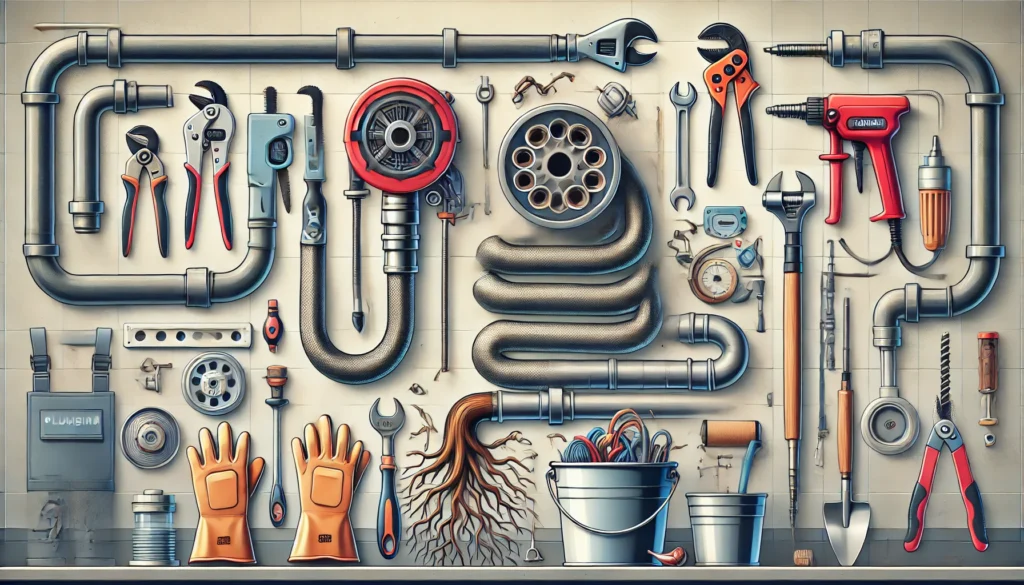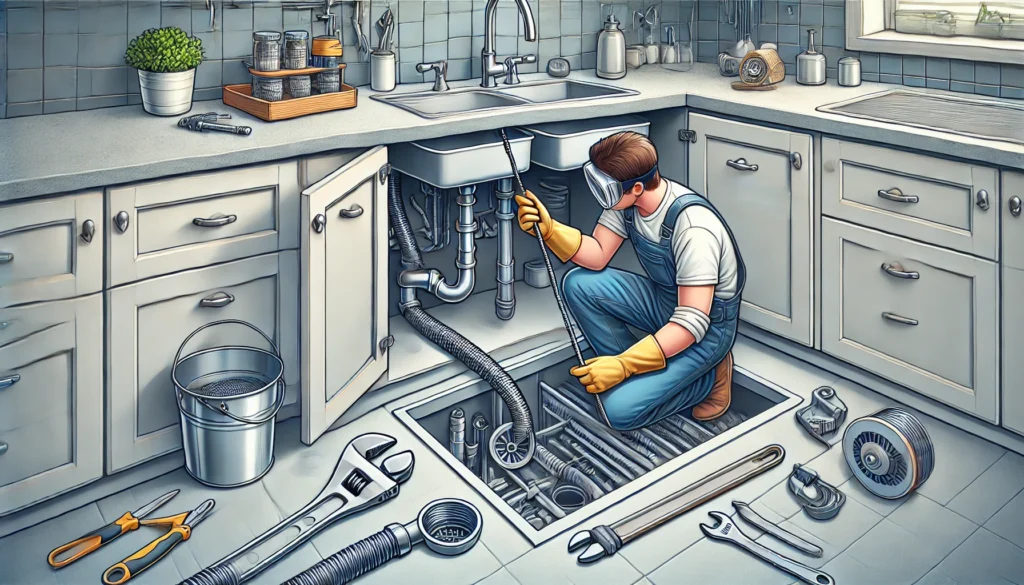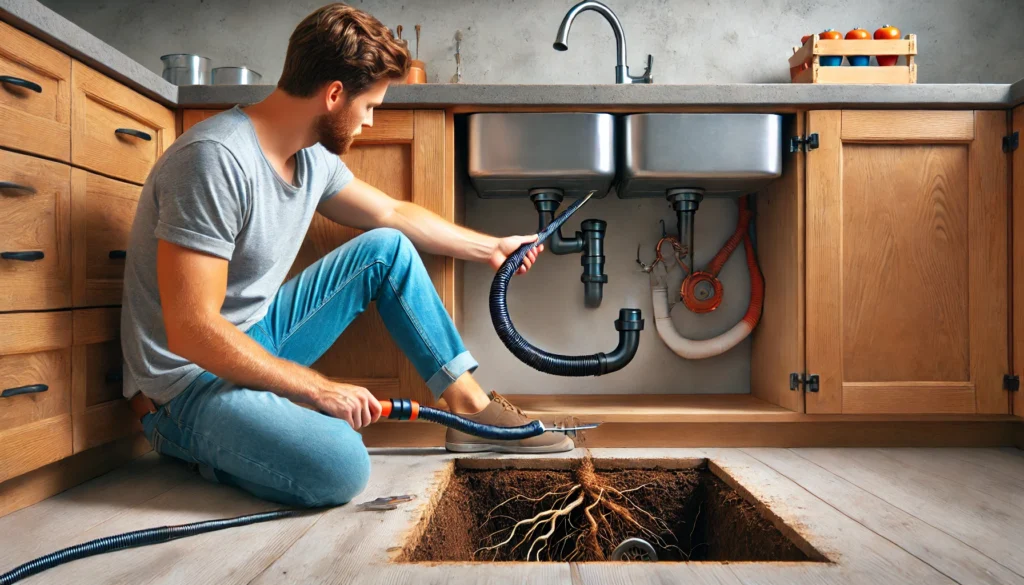When a kitchen sink drain becomes clogged, it can disrupt your daily routine and lead to unpleasant odors, slow drainage, or even standing water. In extreme cases, roots infiltrating the plumbing system can cause significant blockages.
Using a plumber’s snake (also known as a drain auger) is a practical solution to clear these obstructions. This article provides a detailed step-by-step guide to effectively snake a kitchen sink drain, including tips to address root intrusions.
Table of Contents
Understanding the Problem: Why Do Kitchen Drains Get Clogged?
Common Causes of Kitchen Drain Clogs
A clogged kitchen drain can be a frustrating stubborn barrier. This plumbing problem often stems from the accumulation of food particles and grease buildup within pipes. Additionally, the accidental disposal of foreign objects like utensils, jewelry, or small plastics can worsen the clog.
In older homes, tree roots may infiltrate underground pipes, causing severe blockages. And for those with garbage disposals, improper use can contribute to drain clogs.
Identifying the Presence of Roots
Persistent drainage issues like slow drainage, frequent clogs, and unpleasant odors can often point to a more serious problem: roots invading your plumbing system. These invasive roots can cause significant damage to your drain pipes, leading to gurgling sounds as water flow is restricted. While basic plunging and drain cleaners may provide temporary relief, they won’t address the underlying issue.
Tools and Materials Needed
Essential Tools:
To tackle plumbing tasks effectively, you’ll need a few essential tools. A plumber’s snake is a coiled tool designed to dislodge clogs. For stubborn clogs, a strong drain cleaner solution can loosen debris. Gloves protect your hands from bacteria and sharp objects. To work on a sink, a wrench and screwdriver are necessary. A bucket catches water and debris.
Additional Tools for Root Issues:
For heavily infiltrated systems with roots that have cut through pipes, a specialized accessory like a root cutter attachment can be used with a plumbing snake. This tool can effectively cut through roots and clear the blockage.
However, for more severe cases, a high-pressure hydro jet may be necessary. This powerful tool can blast away roots and debris, restoring proper water flow.

Step-by-Step Guide: How to Snake a Kitchen Sink Drain
Step 1: Preparation
Before embarking on the snake a kitchen sink drain process, it’s crucial to prioritize safety and hygiene. Ensure you have the necessary protective gear, including gloves and safety goggles, to safeguard yourself from potential hazards like accidental water flow and exposure to unsanitary conditions.
Additionally, identify the area around the sink that will provide easy access to the plumbing system. This will streamline the subsequent steps and minimize any disruptions to the water supply.
Step 2: Remove the P-Trap
Turn off the water supply. Place a bucket under the P-trap, a curved pipe section that traps water to prevent sewer gas. Use a wrench to loosen the nuts connecting the P-trap to the sink drain and drainpipe. Carefully remove the P-trap and inspect it for debris or blockages. Clean the P-trap thoroughly.
Step 3: Access the Drainpipe
To access the drainpipe, you’ll need to locate the P-trap. This U-shaped pipe, typically found beneath the sink, is a common spot for clogs. Unfasten the P-trap from the main drainpipe and horizontal pipe to gain easier access.
Once removed, you can visually inspect the P-trap for any obvious obstructions. If the clog persists, you’ll need to insert the snake’s head into the pipe opening to dislodge the blockage.
Step 4: Use the Snake
Insert the snake into the drain pipe while holding the handle firmly, turning it clockwise as you advance. If you feel resistance, it indicates you’ve likely reached the clog or an obstruction. Push gently but firmly to break through, using the handle to manipulate the snake effectively.
As the snake encounters debris, withdraw it to clear any loosened material, then repeat the process as necessary until all obstructions and debris are removed.
Step 5: Addressing Root Intrusions
Attach a root cutter to the snake and carefully insert it into the pipes, ensuring it is positioned to effectively tackle intrusive roots. Begin to rotate the snake, allowing the root cutter to break apart the obstruction while removing any residual debris for smooth drainage.
Once the roots are dislodged, flush the system with plenty of water to clear out the remnants. For thoroughness, use a camera to inspect the pipes; this step is optional but can confirm that all roots have been completely cleared. If issues persist, consulting a professional might be necessary.
Step 6: Reassemble and Test
Carefully reattach the P-trap and any other removed components. Ensure all connections are tight to prevent leaks. Turn on the water supply and slowly run water down the drain. Monitor for any signs of leaks around the connections. If you notice any leaks, tighten the connections further.

Tips for Preventing Future Clogs
Regular Maintenance is key to keeping your kitchen sink clog-free. Periodically flush your drain with a mixture of hot water and vinegar. This simple solution can dissolve grease and food particles that may be accumulating.
Additionally, always use a strainer to catch food debris before it goes down the drain. Avoid pouring grease or oil down the sink, as these substances can solidify and cause clogs.
When to Call a Professional
If a clog persists despite repeated snaking attempts or if you suspect roots have infiltrated your pipes, it’s time to call a professional plumber. Extensive damage to your plumbing system can be costly, and standard snake tools may not be sufficient to address complex issues.
Signs of potential damage include slow drainage, gurgling sounds, or foul odors. In such cases, replacement of damaged pipes may be necessary.
Check Similar Guide: How to Clean Vomit Out of a Sink: A Step-by-Step Guide!
Conclusion
A clogged kitchen sink drain can quickly disrupt your daily routine. While severe root problems may necessitate professional assistance, many common clogs can be effectively addressed with a DIY method known as snaking.
This comprehensive guide will walk you through the steps involved in snaking your kitchen sink drain, restoring its functionality, and implementing preventive measures to keep it running smoothly for years to come.
By following these steps and regularly performing maintenance, you can effectively clear clogs, prevent recurring issues, and ensure the optimal performance of your plumbing system.
Frequently asked Questions
What is a plumber’s snake, and how does it work?
A plumber’s snake, or drain auger, is a flexible, coiled tool designed to navigate through pipes to clear blockages. It works by being inserted into the pipe and rotated, breaking up or pulling out clogs like debris, grease, or roots.
Can I use a plumber’s snake for tree roots in kitchen drains?
Yes, but you’ll need a specialized root-cutting attachment for the snake. This accessory slices through roots while the snake is rotated. For severe root problems, consider professional help.
How do I know if my kitchen sink clog is caused by roots?
Persistent slow drainage, unusual gurgling sounds, or recurring clogs can indicate root intrusions. A professional inspection with a camera is the most reliable way to confirm the presence of roots.
What should I do before snaking my kitchen sink drain?
Prepare by clearing the area under the sink, wearing gloves, and placing a bucket beneath the pipes to catch water. Also, disconnect and inspect the P-trap for visible blockages before using the snake.
Do I need to remove the P-trap before using a snake?
Removing the P-trap is recommended for easier access to the drainpipe and to ensure the clog is not in the trap itself. It also prevents damaging the P-trap while snaking.
How far can a plumber’s snake reach into the drain?
Most standard plumber’s snakes can extend 15 to 50 feet, depending on the model. For deeper clogs or root-related issues, a longer snake or professional equipment may be necessary.
What type of snake should I use for kitchen sink drains?
For kitchen drains, a medium-sized hand-crank or motorized snake works well. If roots are involved, choose a snake compatible with root-cutting attachments.
Can snaking a drain damage the pipes?
If used improperly, a snake can scratch or puncture older or weakened pipes. Use gentle pressure and avoid forcing the snake if it encounters resistance.
How do I clean and maintain my plumber’s snake?
After use, wipe the snake clean with a cloth and disinfect it with a solution of water and vinegar or bleach. Dry it thoroughly to prevent rust and store it in a dry place.
What if snaking doesn’t fix the clog?
If snaking fails, the clog might be deeper or caused by significant root intrusion. You may need to use a hydro jet or call a professional plumber for further inspection and repair.
Can chemical drain cleaners be used before snaking?
While chemical cleaners can help loosen clogs, they can also damage pipes over time. If you plan to use a snake, avoid chemicals as they may splash back during the process.
How often should I snake my kitchen drain to prevent clogs?
You don’t need to snake your drain regularly unless issues arise. Instead, focus on preventive maintenance, like using strainers and avoiding grease disposal in the sink.
Are DIY snaking techniques as effective as hiring a plumber?
DIY snaking can resolve most common clogs, but plumbers have advanced tools like hydro jets and pipe cameras to address severe or complex blockages more effectively.
What is the cost of renting or buying a plumber’s snake?
A basic hand-crank snake costs $20–$50, while motorized versions can range from $100 to $300. Renting a professional-grade snake typically costs $30–$50 per day.
How can I prevent roots from infiltrating my drain pipes?
Regularly inspect your plumbing for cracks or damage. If you have nearby trees, consider using root barriers or treating the pipes with root inhibitors to prevent growth into the system.








